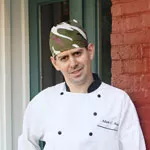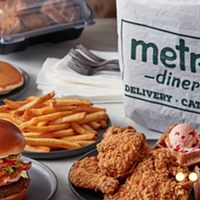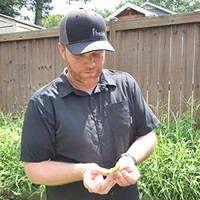Walk with me through a swinging door into Hell. Enormous vats bubble and steam over open flames, sharp knives slice into bloody flesh, boiling oil awaits its next victim. The temperature and humidity form a soupy miasma of overripe odors and dampness, and you must concentrate to stay upright on the slippery floor coated in slime. Everywhere are hard surfaces, scorching metal and red-faced workers screaming "Hot, hot, hot!" as they shove past you. You're the only one without something sharp in your hand, and there's nowhere safe to stand.
Welcome to the professional kitchen. While guests out front sip pinot and pick apart their confit de lapin, the chefs in back are sweating, swearing and having the time of their lives. It takes a special kind of masochist not only to survive, but to enjoy a career back here. Fact is, when you work in Hell, you'd better have a sick sense of humor.
Every chef who thrives in this environment can rattle off any number of horror stories, detailing everything from sadistic hazing to drug-addled co-workers. These tales generally reek of humiliation, will sometimes incorporate blood and, for some reason, frequently feature dead pigs. Faced with these situations, any normal person would tear off their apron and sprint for the door.
Not these characters. Oh no, they stayed and asked for more. Join us as we take you on a tour of these moments, when six local chefs had to make that decision to accept the horror or bolt for the hills. But beware: You may never see their smiling faces and starched white coats the same way again.
BEN PHILPOTT
Executive chef at Block and Grinder
This story is best enjoyed by imagining it told in Philpott's rich Georgia accent with accompanying mimicry — just picture the 6-foot-plus giant pretending to crouch beneath a table.
First restaurant I worked in, a small place in Athens [Georgia], I was a prep dishwasher. I came into work one day and the daytime guy was cowered in a corner of the dishpit. He wouldn't let anybody come near him and he was throwing plates at people.
I was like, "What is this?!" They were like, "Don't worry, somebody's on the way to get him." I was trying to work and not get hit. Every time I got close to him he threw something at me. I was like "Motherfucker!"
I said, "How long has this been going on? Y'all just gonna let him throw plates?" The owner was this big gay Iranian dude. He said, "Ah, he will be done in a minute. Let him work it out."
Nobody could get him out from under the table except for his roommate. His roommate came and got him out from under the table, and he said he'd mixed up all of his drugs that day. It was crazy.
ADAM REED
Executive chef at Santé Restaurant
Reed spent years working for other chefs in his native New York before moving to Matthews, where he now has charge of his own restaurant. You'll have to imagine his intonation rising with indignation as the story progresses.
I worked in the restaurant business for many years, and I had never heard of a grease trap. It wasn't until I was working for this one restaurant, who I'm not gonna name, where the grease police, essentially, came in and said, "Where's your grease trap and when's the last time you cleaned it?"
The owners of the restaurant, who had more money than sense, didn't know what the hell a grease trap was. Somebody just put it in for them because they had to have it. That's all they knew. I remember that they came to me, and I was kind of like the head cook there, and they were like, "So, you need to clean out the grease trap." And I said, "Oh-kaaaay, where is it?"
So the owner and I found the grease trap, which fortunately was just a large metal covered box that was built into the floor of the kitchen. I think it's supposed to hold like 20 to 25 gallons of water. [Note: water flows through the lower part of the box, allowing grease to float to the top and be trapped, keeping it out of the sewer system. This creates a thick layer of mucky grease on top of several gallons of water with other food particles in it.]
Now I worked at this restaurant for well over a year before this question was ever asked. We opened the grease trap up and the most putrid smell that you could possibly imagine emanated from this container, and it was totally encrusted and caked with disgusting gunkness. It was foul. And it was one of those moments where I was like, "Well, I guess I gotta do this."
So I got on some gloves and put some stuff on the ground. And I'm trying to figure out how to scoop this stuff out and find a bucket to put it in. The murk that was on top was inches thick, and I had to break through the stuff to get it out. It made you want to retch, and everybody in the kitchen left.
I eventually get it all scooped out and stuff, and ... the owner was taking the dishwasher out back with the stuff.
Unbeknownst to me was the fact that the owner was having the dishwasher pour this stuff into a storm drain. And that to me now is like, "Oh God, the horror!" Because that [drain] is not for that kind of liquid to go in. That is just supposed to be pure, straight runoff rainwater.
I remember coming outside and being like "Oh my God, that's a storm drain!" There was spillage happening, so there's a reeking smell outside now, and then hoses are emerging to spray ... We still had more to get rid of, and at that point I embarrassingly — knowing what I know now — just kind of was like, "Oh well, the hell with it. It's going in there now, at this point we don't know any better."
That first time was the only time it went in there. When I had my own place, that's when I learned they had people who took care of that grease stuff for you. 'Cause that's not something anybody teaches you. Whoever teaches you that there are service companies for cleaning out a grease trap that you're not even aware exists?
NICK DANIELS
Former executive chef at Wooden Vine
Getting his start in Chile and Spain, Daniels has experienced crazy kitchens in a variety of cultures. This story of a co-worker's brilliant revenge took place at an upscale restaurant in Barcelona.
A couple of funny things I've seen you just couldn't help but laugh at, it was just so bad. We worked a 16- to 32-course tasting menu, and messing up could be [as small as] missing two flowers on a dish. We had a new kid that kept messing up, messing up, messing up. The third time, they fired him.
He was like, "You guys have been riding my ass for so long, I just started here ... You know what? Fuck this!" He grabs every ticket off the rail and throws them on the wood-burning grill. And they just poof! [Daniels' hands rise like ashes from the flames.]
And everybody's just standing there ... The chef's angry, but the rest of us are like, "I don't know whether to clap or be quiet, but that was the ballsiest thing I've ever seen anyone do. You screwed us up for the rest of the night. Thank you."
PAUL VERICA
Executive chef/owner at Heritage Food & Drink
The conscientious chef's worst nightmare is unnecessary loss of expensive product. Especially when it's from a farmer you know well.
Joe Bonaparte [former department chair at the Art Institute of Charlotte] and I did a head-to-tail dinner with Sammy [Koenigsberg of Newtown Farms] when I was at the [Longview Country] Club. Sammy brought the pig right from the slaughterhouse, and it was in a cooler, still warm.
I didn't think about it, threw it in the [walk-in] cooler. I go to look at it the next day, to start butchering it and processing it, and it [had] rotted, because it was still warm and I just closed it and stuck it in the cooler, figuring, "Eh, it's 40 degrees in here, it'll be fine." I didn't think about that the cooler as well as keeping things cold, will keep things warm. So it maintained the temperature of the carcass.
It was the most unpleasant smell. I'll never forget the smell of that.
TERRA CIOTTA
Culinary instructor at Art Institute of Charlotte
There's a definite theme developing here, as you'll notice in Ciotta's spooky story. This writer has heard her partner tell this story a few times, about a chilly culinary tête-à-tête in the school's walk-in cooler.
The only time I've broken down pig heads is when Joe [Bonaparte] left two pig heads in the freezer at school. I pulled them out and I was like, "You've got to do something with these heads. Like, get this shit out of my freezer or I'm throwing them away." And he says, "OK, we're gonna make ..." whatever the hell we were going to make.
So he sends me from the Matthews market to school by myself, and he says, "Well, just take the tongue out." I'm standing in the walk-in cooler by myself — and you know what the light in a walk-in is like — and they're staring at me.
I've got my hands in their mouth trying to cut the tongue out. I'm going every direction I can possibly figure out to get this thing. It was so creepy, I was so scared one of them was going to wake up and start oinking at me. I was like, "There's no way I can do this shit." But I did it.
KRIS REID
Executive chef at Southminster
You can't make this stuff up. Our final story is from Reid's early days learning the craft at culinary school in Mexico. She has vivid memories from her first dia de carne, or meat day, when the school received loads of carcasses fresh from the slaughterhouse.
So they come in with carcasses, most of them are heads off, halved, but it's just piles of meat.
So I go down to the basement. It smells awful, it's at least 120 degrees down there, in Mexico in the middle of summer, it's fuckin' hot. There's flies. I'm already really nauseous, I'm hungover as well.
So I go down there and I look around and [the chef] is like "Oh, dia de carne!" He's showing me all the animals, he's all excited about it, and I was "OK, so what do you want me to do?" And he takes this pig head out of a bag, and he slops it on the table in front of me. It splatters all over me. "Break that down." I was like, "What?" And he leaves!
He leaves the knife, and he leaves a big drippy pig head looking at me. There's a fan that had one of those pull cords on it, and it was going "tink, tink, tink, tink, tink..." The light was so bad down there and I actually felt myself starting to fall backwards. I thought I was going to pass out, it was awful.
But I fucking broke that bitch down. Ears, eyes, fucking cracked it open, fucking took the brains out. I had to put the cleaver [on the head] and I used the hammer, bam bam bam. Old school, I mean, what was I supposed to do?
He walked in, he looks at it. I'm covered, because it was a dirty job. I've never done it before, it wasn't pretty. There was shit everywhere, I'm sure there were brains scattered all over the place. He walks in and asks, "How are we doing?" And I was like, "Cesos, ojos [brains, eyes]..." He's like, "Bueno!! Posole!" [Writer's note: Here's a bit of fun history for ya. Posole, a stew, originated with the Aztecs, who made it with human flesh. The Europeans made them substitute pork, which apparently tastes the most similar.]
I was like, "Yeah, I did it right!"
I'm sure he was thinking, "That was awful." I'm sure he did not think I did a good job, but I was really proud of the job that I did.
Speaking of...
-

Mad Monster Party: a Charlotte tradition
Feb 15, 2019 -

Halloween: The Shape of Things Too Dumb
Oct 19, 2018 -

Black Wednesday's Corri Smith Knows How to Build a Brand... and Throw a Party
Oct 17, 2018 - More »
Latest in Cover Story
More by Alison Leininger
Calendar
-

Charlotte Wine + Food Week Presented by Truist @ Charlotte, NC
-

Charlotte Wine & Food Week’s Annual Sake Dinner at Mizu @ Mizu
-

Hands On Cocktail Class Featuring Gin at DTR Southpark @ DTR SouthPark
-

Angeline’s Featuring Sciandri Family Vineyards @ Angeline's
-

Aria Tuscan Grill Featuring Allegrini - Charlotte Wine + Food Week @ Aria Tuscan Grill
-
Elizabeth Anne Dover Brings a Vineyard to NASCAR Country
Napa South
-
Dorie Greenspan's Tiramisu Cake
This layered cake is definitely a "pick-me-up" with a little booze and caffeine.
-
Cotswold Enters the Food Truck Frenzy 1
Friday night lights, redux



















